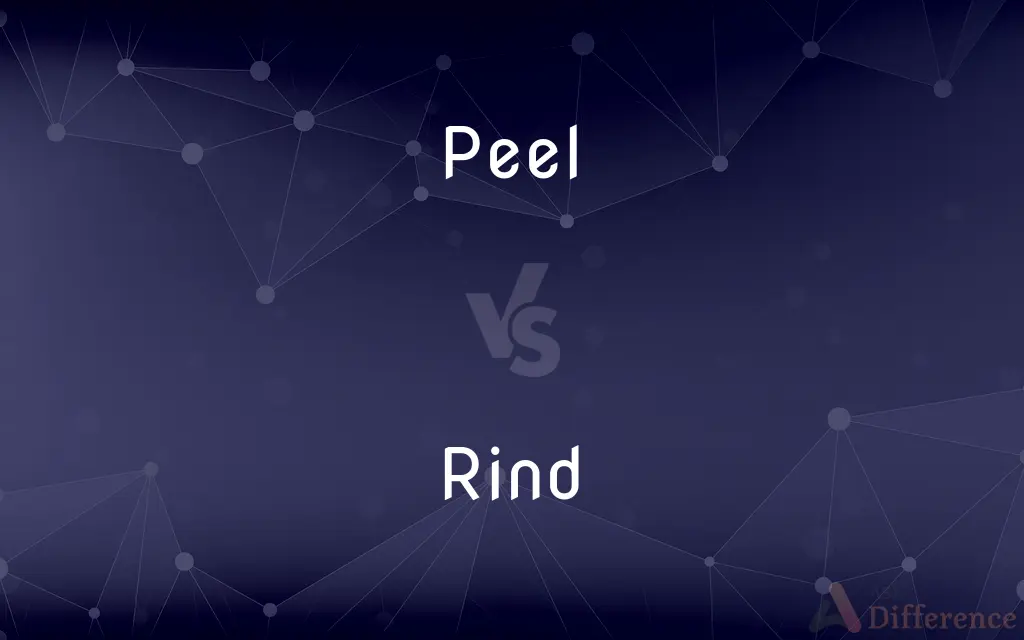Peel vs. Rind — What's the Difference?
Edited by Tayyaba Rehman — By Urooj Arif — Updated on March 29, 2024
Peel refers to the outer skin of fruits and vegetables, typically removed before consumption, while rind is the thicker, harder outer layer of certain fruits, cheeses, and meats, often consumed or used in cooking.

Difference Between Peel and Rind
Table of Contents
ADVERTISEMENT
Key Differences
The term "peel" usually describes the outer skin of fruits and vegetables, such as oranges, bananas, and potatoes. It is often thin and can be removed using a knife or by hand, serving as a protective layer for the inner edible parts. Peels are frequently discarded, although they can be used in various culinary applications due to their aromatic oils and flavors. On the other hand, "rind" refers to a thicker, more substantial outer layer found on certain fruits like watermelons and hard cheeses such as Parmesan. Rinds can serve not only as a protective barrier but also contribute to the flavor and texture of the food.
While peels are generally considered a byproduct of food preparation, they contain nutrients and fiber that can be beneficial to health. Citrus peels, for example, are high in vitamins and can be zested to add flavor to dishes. In contrast, rinds, especially those on cheeses, are often integral to the product's character, imparting distinct flavors and textures that are developed during the aging process. Some rinds are edible and valued for their taste, while others are too hard or bitter to consume.
In culinary contexts, the decision to remove or use the peel or rind often depends on the recipe and personal preference. For instance, potato peels might be left on for added texture and nutrients in a rustic mash, while orange peels can be candied or zested. Rinds from hard cheeses can be added to soups and stews to enrich the flavor, showcasing their utility beyond mere protection.
Environmental considerations also play a role in how peels and rinds are perceived and utilized. With increasing awareness of food waste, both peels and rinds are being explored for their potential in reducing waste and enhancing sustainability in cooking practices. This reflects a broader understanding of their value, extending beyond traditional uses to innovative culinary and ecological applications.
Comparison Chart
Definition
Outer skin of fruits and vegetables
Thicker, harder outer layer of fruits, cheeses, and meats
ADVERTISEMENT
Thickness
Thin and easily removable
Thicker and sometimes hard
Edibility
Often removed and discarded, but can be edible
Varies; can be an essential part of the flavor profile
Nutritional Value
Contains vitamins, minerals, and fiber
May contribute to flavor; nutritional value varies
Usage
Often removed before consumption; used in zest and garnishes
Often consumed or used in cooking for added flavor
Culinary Examples
Citrus peels, apple skins
Watermelon rind, Parmesan cheese rind
Compare with Definitions
Peel
The outer skin of fruits and vegetables.
She carefully removed the orange peel to use in her cake recipe.
Rind
Integral to the flavor of certain cheeses.
The rind of Brie cheese is edible and adds to its character.
Peel
Can be zested for flavor.
Lemon peel adds a bright note to desserts and sauces.
Rind
The thick outer layer of some fruits and cheeses.
The watermelon rind was composted after the picnic.
Peel
Frequently discarded but can be used creatively.
Candied citrus peels make a delightful treat.
Rind
Sometimes hard and inedible.
The thick rind of some aged cheeses is not meant to be eaten.
Peel
Often thin and colored.
The apple's red peel contrasted beautifully with its green flesh.
Rind
Offers a texture contrast.
The rind on bacon imparts a crisp texture when cooked properly.
Peel
Contains essential oils and nutrients.
Potato peels are rich in fiber and vitamins.
Rind
Can be used to add depth to dishes.
A piece of Parmesan rind simmered in soup enhances its savory richness.
Peel
Remove the outer covering or skin from (a fruit, vegetable, or prawn)
She watched him peel an apple with deliberate care
Rind
A tough outer covering such as bark, the skin of some fruits, or the coating on cheese or bacon.
Peel
Remove a thin outer covering or part
I peeled off the tissue paper
Rind
Tree bark
Peel
(of a surface or object) lose parts of its outer layer or covering in small strips or pieces
The walls are peeling
Rind
A hard, tough outer layer, particularly on food such as fruit, cheese, etc
Peel
Send (another player's ball) through a hoop
The better players are capable of peeling a ball through two or three hoops
Rind
The gall, the crust, the insolence; often as "the immortal rind"
Peel
The outer covering or rind of a fruit or vegetable
Pieces of potato peel
Rind
An iron support fitting used on the upper millstone of a grist mill.
Peel
A flat implement like a shovel, especially one used by a baker for carrying loaves or similar items of food into or out of an oven
A wooden pizza peel
Rind
(transitive) To remove the rind from.
Peel
A small square defensive tower of a kind built in the 16th century in the border counties of England and Scotland.
Rind
The external covering or coat, as of flesh, fruit, trees, etc.; skin; hide; bark; peel; shell.
Thou canst not touch the freedom of my mindWith all thy charms, although this corporal rindThou hast immanacled.
Sweetest nut hath sourest rind.
Peel
The skin or rind of certain fruits and vegetables.
Rind
To remove the rind of; to bark.
Peel
A chemical peel.
Rind
The tissue forming the hard outer layer (of e.g. a fruit)
Peel
A long-handled, shovellike tool used by bakers to move bread or pastries into and out of an oven.
Rind
The natural outer covering of food (usually removed before eating)
Peel
(Printing) A T-shaped pole used for hanging up freshly printed sheets of paper to dry.
Peel
A fortified house or tower of a kind constructed in the borderland of Scotland and England in the 1500s.
Peel
To strip or cut away the skin, rind, or bark from; pare.
Peel
To strip away; pull off
Peeled the label from the jar.
Peel
To lose or shed skin, bark, or other covering.
Peel
To come off in thin strips or pieces, as bark, skin, or paint
Her sunburned skin began to peel.
Peel
(transitive) To remove the skin or outer covering of.
I sat by my sister's bed, peeling oranges for her.
Peel
(transitive) To remove something from the outer or top layer of.
I peeled (the skin from) a banana and ate it hungrily.
We peeled the old wallpaper off in strips where it was hanging loose.
Peel
(intransitive) To become detached, come away, especially in flakes or strips; to shed skin in such a way.
I had been out in the sun too long, and my nose was starting to peel.
Peel
(intransitive) To remove one's clothing.
The children peeled by the side of the lake and jumped in.
Peel
(intransitive) To move, separate (off or away).
The scrum-half peeled off and made for the touchlines.
Peel
(curling) To play a peel shot.
Peel
(croquet) To send through a hoop (of a ball other than one's own).
Peel
To plunder; to pillage, rob.
Peel
The skin or outer layer of a fruit, vegetable, etc.
Peel
The action of peeling away from a formation.
Peel
(obsolete) A stake.
Peel
(obsolete) A fence made of stakes; a stockade.
Peel
(archaic) A small tower, fort, or castle; a keep.
Peel
A shovel or similar instrument, now especially a pole with a flat disc at the end used for removing pizza or loaves of bread from a baker's oven.
Peel
A T-shaped implement used by printers and bookbinders for hanging wet sheets of paper on lines or poles to dry.
Peel
The blade of an oar.
Peel
An equal or match; a draw.
Peel
(curling) A takeout which removes a stone from play as well as the delivered stone.
Peel
A small tower, fort, or castle; a keep.
Peel
A spadelike implement, variously used, as for removing loaves of bread from a baker's oven; also, a T-shaped implement used by printers and bookbinders for hanging wet sheets of paper on lines or poles to dry. Also, the blade of an oar.
Peel
The skin or rind; as, the peel of an orange.
Peel
To plunder; to pillage; to rob.
But govern ill the nations under yoke,Peeling their provinces.
Peel
To strip off the skin, bark, or rind of; to strip by drawing or tearing off the skin, bark, husks, etc.; to flay; to decorticate; as, to peel an orange.
The skillful shepherd peeled me certain wands.
Peel
To strip or tear off; to remove by stripping, as the skin of an animal, the bark of a tree, etc.
Peel
To lose the skin, bark, or rind; to come off, as the skin, bark, or rind does; - often used with an adverb; as, the bark peels easily or readily.
Peel
To strip naked; to disrobe. Often used with down .
Peel
The tissue forming the hard outer layer (of e.g. a fruit)
Peel
British politician (1788-1850)
Peel
The rind of a fruit or vegetable
Peel
Strip the skin off;
Pare apples
Peel
Come off in flakes or thin small pieces;
The paint in my house is peeling off
Peel
Get undressed;
Please don't undress in front of everybody!
She strips in front of strangers every night for a living
Common Curiosities
Can you eat the rind on cheese?
Yes, many cheese rinds are edible and contribute to the cheese's overall flavor, though some are too tough to eat.
Are there any health benefits to eating the rind?
The health benefits depend on the specific rind; some, like citrus rinds, contain vitamins and antioxidants.
Is the peel always removed before eating?
Not always; the decision to remove the peel depends on the type of fruit or vegetable and personal preference.
What can you do with leftover peels?
Leftover peels can be used in cooking to add flavor, composted, or utilized in DIY skincare recipes.
Why do some cheeses have rinds?
Rinds form naturally during the cheese aging process and can protect the cheese, as well as add flavor and texture.
Can rinds be composted?
Many rinds, especially from fruits and vegetables, can be composted, though thicker ones may take longer to break down.
How can I tell if a rind is edible?
Research the specific cheese or fruit; if the rind is soft and from a reputable source, it is likely edible. When in doubt, ask a culinary expert or cheesemonger.
Do peels and rinds have any culinary uses?
Yes, both can be used in various culinary applications, from adding flavor to dishes to serving as garnishes.
Can the texture of a rind affect a dish's flavor?
Yes, the texture of a rind can add complexity to dishes, either through direct consumption or by infusing dishes with flavor during cooking.
What's the difference between zest and peel?
Zest is the colored outer layer of citrus fruit peel, used for its flavor, while peel refers to the entire outer skin.
What's the nutritional difference between peel and rind?
Nutritional content varies widely; fruit peels often contain fiber and vitamins, whereas cheese rinds' nutritional value depends on the cheese type.
How do you remove tough rinds from cheeses?
A sharp knife can be used to carefully cut away the hard rind from cheeses before consuming or using the cheese in recipes.
How should peels be stored if not used immediately?
Peels should be stored in an airtight container in the refrigerator if not used immediately to preserve their freshness and nutrients.
Is it safe to use the peel of non-organic fruits?
Non-organic fruit peels may contain pesticide residues; washing thoroughly or choosing organic are recommended practices.
Share Your Discovery

Previous Comparison
Fluxbox vs. Openbox
Next Comparison
Photoshop vs. SketchAuthor Spotlight
Written by
Urooj ArifUrooj is a skilled content writer at Ask Difference, known for her exceptional ability to simplify complex topics into engaging and informative content. With a passion for research and a flair for clear, concise writing, she consistently delivers articles that resonate with our diverse audience.
Edited by
Tayyaba RehmanTayyaba Rehman is a distinguished writer, currently serving as a primary contributor to askdifference.com. As a researcher in semantics and etymology, Tayyaba's passion for the complexity of languages and their distinctions has found a perfect home on the platform. Tayyaba delves into the intricacies of language, distinguishing between commonly confused words and phrases, thereby providing clarity for readers worldwide.














































